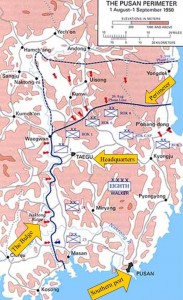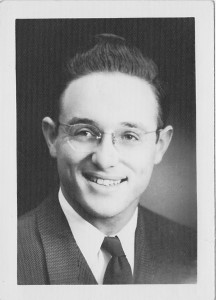05 Jun Ace Allen
On August 9, 1950, my Uncle Ace was killed in Korea. We’ve never known much about what happened. I’m writing this in hopes that there might be someone “out there” who remembers him.
Ace was the baby of the family. When he enlisted right after high school in 1943, he became his mother’s third son to be serving overseas with World War II’s Army Air Force. Ace was a member of the 317th Service Group which saw service in England, Belgium, and France. While in England he was stationed at Cottesmore, an RAF base that had been turned over to the Americans. He was an airplane propeller specialist doing repair work on C-47s, the huge transport planes that flew troops, cargo, and the wounded.
As soon as the war was over Ace entered the State College of Washington in Pullman near where his mother lived. Just as in high school, he was in the R.O.T.C. This time his goal was to become an officer. During his senior year, his mother received a letter that Ace had been selected as a Distinguished Military Student, eligible to apply immediately for a direct commission in the Regular Army as a second lieutenant. On June 15, 1950, Ace did just this. He had reached his goal.
Because his college did not have an Air Force R.O.T.C., Ace was in the Army. Years later his brother made the comment that when Ace decided that he would join the Army as a career officer our country was not at war. If the Korean War had broken out first he might not have joined.
Writing about Korea has been difficult. We just don’t talk about the Korean War, do we? If your eyes begin to glaze over about halfway through this, mine did too. Any of the city names could be an excellent computer password, and names have changed since the 1950s. I’ve tried to make it as understandable as possible and welcome any and all corrections. Most of my information has come from Roy E. Appleman’s excellent book South to the Naktong, North to the Yalu.
The country of Korea is about the size of the state of Utah. For years it was controlled, not so nicely, by Japan, and as part of the Japanese surrender in 1945 the country was divided into zones, one in the South controlled by the United States, in the North by the Soviet Union. The people of Korea would not have long to celebrate a time of peace.
Over the next few years, relations between the North and the South deteriorated. The newly formed United Nations tried to orchestrate peace but to no avail. The government of North Korea, sponsored by the Soviets, wanted to oust the U.N. Commission and take complete control of the country. The North Korea People’s Army included in its ranks veteran Chinese Communist Forces and all were armed with Soviet Union military equipment. The South Koreans, aided by the United States, didn’t appreciate at first the strength of their opposition.
The North Korean invasion began on the 25th of June, 1950. The South was caught unawares as war was declared against them. So was Washington. According to military historian Appleman, “The surprise in Washington on Sunday, 25 June 1950, according to some observers, resembled that of another, earlier Sunday – Pearl Harbor, 7 December 1941.”
On June 30th President Truman announced in a press release that the United States was in the war.
As June turned into July the North Koreans successfully fought their way south and conquered city after city. The American troops who had quickly moved from Japan were not experienced in combat. Summer months in Korea meant temperatures reaching 110 degrees. Men were literally dying of heat exhaustion. Rations were disappointing. Morale was low, losses were heavy, and their officers were crying out for replacements.
By the end of July and beginning of August, reinforcements were finally arriving. 2nd Lt. Ace Allen was ordered to Fort Lewis on July 15th as part of the 9th Infantry Regiment of the 2nd Infantry Division. They sailed from Tacoma, Washington two days later, the first Army infantry troops to depart from the United States for Korea. On July 31st they landed in Pusan, (today called Busan) a southernmost port, the most important one in the country.
There had been no time for serious training. On the way there the officers and soldiers were hurriedly taught, among other things, how to use the 3.5-inch rocket launcher, a newer and larger bazooka weapon.
The troops went first to a spot about ten miles southeast of Taegu (today known as Daegu) where the division headquarters was located. They had orders to be prepared to move out with an hour’s notice. Taegu was a city of great importance in the North Korean push to get to Pusan, the best port in the country as well as the origin of the important railroad lines.

The Pusan Perimeter in the southeast corner of Korea … 5,000 square miles … slightly smaller than Connecticut. (The map was created by the Center for Military History and used in the brochure “The Korean War: The Outbreak.” Labels by me.)
The United Nations forces were defending what was called the Pusan Perimeter, a rectangular area about 100 by 50 miles, slightly smaller than the state of Connecticut. If you want to have an idea of the terrain just click on Google Maps and select the satellite view. It looks like it would have been almost impossible to travel anywhere, and it was. Steep slopes, mucky rice paddies, rain, and rats.
The North Koreans were attempting, with some success, to cross the Naktong River (also known as the Nakdong River) in order to advance toward Pusan. A series of attacks back and forth from the hilly terrain and down to the valleys did not keep the North Koreans from pressing forward.
At 4:00 pm on the 7th of August, Ace’s regiment went into active combat. They were ordered to attack the North Koreans at a bulge in the river, the Naktong Bulge. There was fierce fighting in an atmosphere of chaos for several days resulting in heavy casualties.
In the early months of the Korean War, there just wasn’t enough time to keep detailed records of everything that happened. All the family learned was that 2nd Lt. Ace Allen was a platoon leader in the leading unit assigned to clear out a valley. And that on the 9th of August he was killed in action.
The army notified Ace’s mother later in August. “The unit suffered heavy casualties, but accomplished its mission bravely and heroically.” On September the 14th she received back from the Army a packet of letters she had written almost daily to her “dearest boy.” Each was stamped “Verified Deceased.”
A few days ago I began to delve into Korea, for the first time I might add, and did a hard google of “Ace Allen Korea.” Lo and behold … in not even three minutes I found an article on the Washington State Cougars website. Written by Jason Krump, Washington State University Athletics, it tells about a Veterans Memorial at the University.
Egad! I read: “The motivation for the creation of the memorial came from the story of an individual who fought in two wars, but whose narrative, and those of his comrades, became overlooked by the emotions stemming from another war.
“Dedicated in 1993 and rededicated when it was completed in 2000, the memorial is the brainchild of C. James Quann, veteran of the Korean War, former WSU Registrar, and author of the book “WSU Military Veterans: Heroes and Legends.” …
“As a freshman arriving at Washington State College in 1950 (the school would become Washington State University in 1959), Quann and his classmates were told of the exploits of Ace Allen, who graduated just a few months prior to Quann’s arrival on campus. Allen served two and a half years in the Air Force during World War II, attended WSC under the GI Bill, and upon graduation, returned to the front line in Korea. It was there he was killed in action on Aug. 9, 1950, just two months following his commencement from WSC.”
Now I’m positive that someone might remember my uncle and his exploits.
If any of my readers have any information that will be helpful to us please comment below or email pat@libertyladybook.com. THANK YOU. We can never thank our veterans enough.




No Comments